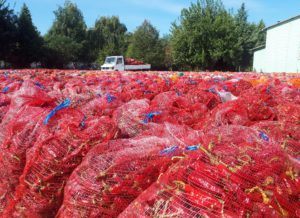Autumn is the busiest time of the agricultural year and it’s true for the red spice paprika varieties, too. Picking, post-harvest ageing and processing was always an arduous job and it is no different today.
Harvest traditionally started on 8 September, the Day of the Blessed Virgin Mary and ended before frost set in or until red fruits were on the plant. These days, however, we tend to start picking earlier because the generally hotter summers colour and ripen the fruits a few weeks earlier, so it is not rare to see people picking paprika as early as around 20 August. Harvest time today normally ends with a second or third harvest in mid to end of October, though the last picks never offer much in terms of quantity and quality. When it is the frost that harvests paprika, people are sad: all the work that went into plant care from March can be over within a night. In 2013 frost on the night of the 5th of October harvested 70% of the country’s entire paprika yield.
Paprika today can be hand-picked or machine-harvested. There are a few varieties that have been selected and developed for machine harvest: these varieties bring and ripen fruits at about the same time, so when the machine picks all the fruits, most are red and ripe.
Most varieties are not good for machine harvest, however. These bring fruit continuously, in several floors: the first floor ripens first, which we hand-pick first. A few weeks later we go back for a second or sometimes a third pick, when we hand-pick the second and third floor’s fruits. Hand-picking is extremely arduous: you need to blend low and stay like that for days.
In the past autumn picking was a wonderful site around Szeged: groups of 20 or 30 people were picking the red fruits, emptying baskets into sacks and men walking long ways with sacks on their backs to put them on carts, which took the harvest home for stringing and drying. Harvest brought family, friends and neighbours together and it was evident that the favour of helping in the harvest had to be returned.
Post-harvest ageing in Hungary is a necessary part of processing the fruits. This means no other than the paprika fruits in bags, crates or long garlands sit in the sun for 2 to 4 weeks, waiting for their turn to be processed. During this ageing time the paprika fruits are turning a darker shade of red, their membranes inside are turning red and the seeds yellow. The sugar content of the fruit is decreasing and at the same time helping red pigmentation of the fruit. Without this post-harvest ageing process the paprika powder becomes orange-colour and loses colour too quickly.
What helps this ripening or reddening process? Lots of sunny days, pleasant autumn weather and lots of careful hands that help air the fruits.
Tetszett a cikk? Ha szeretne még paprikás és fűszeres témában, heti rendszerességgel cikket olvasni, hírt kapni az ÚJ paprika elkészültéről, iratkozzon fel hírlevelünkre. Subscribe to our Blog and enjoy our Paprika Poster.







